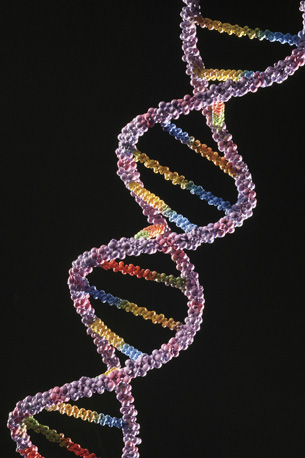Module 7
1. Module 7
1.3. Lesson 1
Module 7—Molecular Genetics: DNA, RNA, and Protein Synthesis
Lesson 1—DNA Structure
 Get Focused
Get Focused

© 2008 Jupiterimages Corporation
All organisms begin life as a single cell. All the information for forming body parts and controlling body processes must be stored in that single, original cell. As stated in the Cell Theory from Science 10, cells are the basis of the following:
- structure
- function
- heredity for all living things
The work of many scientists, various events, and experiments led up to the identification of the molecule that holds all of this cellular information, DNA (deoxyribonucleic acid). During the process of discovery, some scientists concentrated on identifying the molecule of heredity while, simultaneously, others were studying the structure of DNA. The combination of identifying DNA as the molecule of heredity, and the discovery of the DNA structure itself allowed scientists to begin searching for the mechanisms and processes involved in passing genetic information from one generation to the next. Once the molecule responsible for passing on all information to the next generation was identified, scientists imagined the possible applications of this knowledge.
The discovery of DNA also caused the imaginations of cartoonists to take new directions. If this DNA were changed, what would happen to a person? Think of comic superhero Spiderman. The age of mutant superheroes began.
This lesson will address the following focusing questions:
- What is the history of the discovery of DNA?
- What is the structure of DNA?
- What is the significance of finding the DNA code?
DNA (deoxyribonucleic acid): a double-stranded nucleic acid molecule that governs the processes of heredity in the cells of all organisms
It is composed of nucleotides containing a phosphate group, a nitrogenous base, and deoxyribose.
 Module 7: Lesson 1 Assignment
Module 7: Lesson 1 Assignment
Your teacher-marked Module 7: Lesson 1 Assignment requires you to submit responsed to the following:
- “Thought Lab 18.1: DNA Deductions” from page 629 of the textbook for assessment
Download a copy of the Module 7: Lesson 1 Assignment to your computer now. You will receive further instructions on how to complete this assignment later in the lesson.
The other questions in this lesson are not marked by the teacher; however, you should still answer these questions. The “Self-Check” and “Try This” questions are placed in this lesson to help you review important information and build key concepts that may be applied in future lessons.
After a discussion with your teacher, you must decide what to do with the questions that are not part of your assignment. For example, you may decide to submit to your teacher the responses to “Try This” questions that are not marked. You should record the answers to all of the questions in this lesson and place those answers in your course folder.
Remember, you also have the option of trying additional questions from the textbook for further practice. Consult with your teacher for the answers to these questions. The Key will also provide you with many Diploma Exam-style multiple-choice, numerical-response, and written-response questions that will be an excellent review of the module. Practising your responses to these types of questions is good preparation for the Diploma Exam.
Required Materials and Equipment
paper, scissors, and pencil crayons (if paper model is chosen)